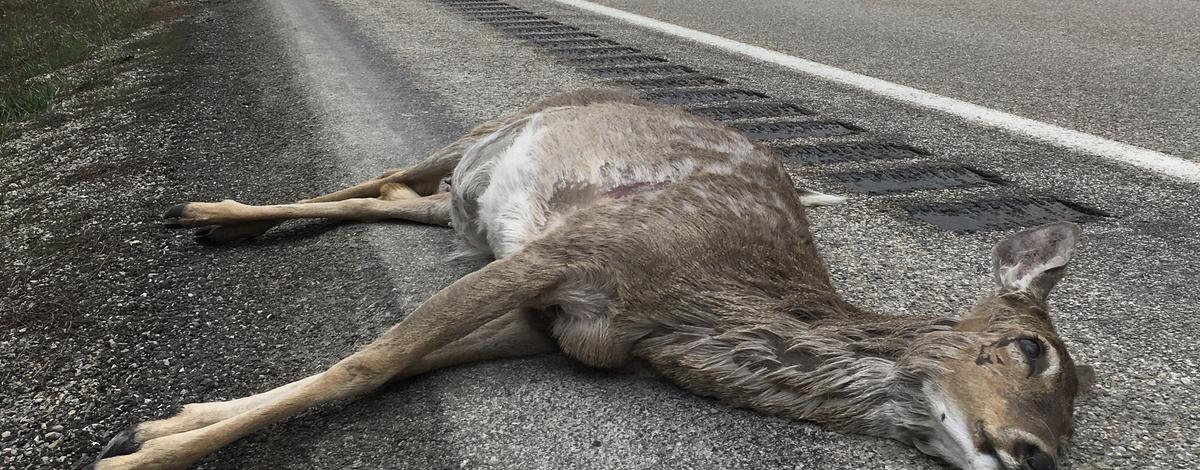Seeing a road-killed animal may be sad, but it might also provide a clue to more effective wildlife management.

Hilary Turner works for the Idaho Fish and Game as a roadside carcass surveyor in the Upper Snake Region. She drives US-20 from Idaho Falls to the Montana border searching for carcasses and collecting data.
“Why?” you may ask.
Ecology is the study of interactions and relationships between organisms and their environments. Road ecology is an emerging science where scientists study the ecological effects of roads, which Turner does by collecting data on road kills.
From two-tracks to interstates, most people use some kind of road in their daily lives. The United States alone contains 4.12 million miles of road (2.68 million paved miles) and the ecological effects (direct and indirect) of this transportation system are vast.
Learning from history
The ecological effects of roads have been studied in Idaho since at least the late 1960s, when Fish and Game documented the effects of the completion and opening of Interstate 84 in southern Idaho on the migratory Sublett mule deer herd. The freeway opened in November, 1969, and in the next six weeks, 18 mule deer were killed by vehicles.
For a herd that historically migrated southwest from summer range in the Sublett Mountains to winter range in the Black Pine Mountains, I-84 became an impediment to migration. Some animals were unable, or unwilling, to cross the freeway, and many were killed as they attempted to cross it.
The interstate altered their migration route, and many deer remained on the east side of the freeway and spent winters near Snowville, Utah. That winter range had insufficient forage for deer, and during the following winters, an estimated 40 percent of the herd died of malnutrition.
In an attempt to pass cattle safely across the road, as well as restore this important migration route, crossing structures in the form of underpass culverts were eventually installed. Without wildlife-proof fencing to help funnel deer to the culverts, the project was ineffective at restoring the migration route.
Improvements were made to the culverts since then, and some deer now cross under the road successfully. But some biologists estimate the deer herd is currently less than half of what it was in the 1960s due to the freeway, which still acts as an impediment to migration. The story of the Sublett mule deer herd demonstrates both the direct and indirect effects of roads on wildlife.
Often, the indirect effects of roads can be as severe, or more, than the direct wildlife mortality. Habitat is lost and fragmented when roads are built. Animals have a harder time accessing resources and moving throughout their home ranges. Migrations are lost or changed due to the barrier effect of roads.
To further complicate things, deer, elk, pronghorn and other animals' migrations depend on learned and socially transmitted information, which if lost, can take decades to restore.
Noise, light, and chemicals also pollute roadside habitat for up to several hundred feet beyond the side of the road. Disturbed roadsides provide ideal habitat for invasive plant and animal species. Litter, intended or not, finds its way into ecosystems throughout the year via roads.
Beyond big game
People often think of the large animals that are directly killed on roads because we can see the evidence that deer and elk are hit, even skunks, raccoons, and owls are commonly observed. But the direct effects of roads are much farther reaching than what typically meets the eye.
Billions of insects, birds, reptiles, amphibians, and small mammals are killed annually on roads. Some studies estimate that up to one million animals are killed each day on roads in the U.S. Using the work done in Idaho as an example, since December 2017, Turner has documented over 700 unique dead organisms on a 63-mile stretch of US-20 in Southeast Idaho. Because carcasses do not persist long on roadways, Turner said she may be missing up to 14 times the number of small animals that are found.
Before getting a negative feeling about roads, not all is lost. Fish and Game has a memorandum of understanding with Idaho Transportation Department, and the agencies work together toward solutions for some of the ecological problems associated with Idaho’s roads.
Not just a wildlife problem
Because wildlife/vehicle collisions are also safety risks for drivers, ITD has an interest in projects that reduce them, and the agency works with Fish and Game to implement them. It is through this agency collaboration that the road-kill carcass survey is possible. Carcass surveys provide valuable information about mortality hotspots, which can be used to determine appropriate wildlife/vehicle collision mitigation siting and what methods to use.
ITD and Fish and Game have already collaborated on mitigation projects, including the wildlife underpass and fencing that was installed on US-21 near the Boise River Wildlife Management Area. Trail cameras have documented wildlife using the underpass. A wildlife overpass with fencing is also planned for the near future on US-21 to reduce wildlife-vehicle collisions and improve habitat connectivity.
Other projects include wildlife underpasses and fencing in the Coeur d’Alene region, and barn owl collision mitigation in the Twin Falls area.
You can help save animals, and prevent vehicle repairs
Remember, as a driver, you can also do your part to make a difference for animals. Fall and spring are the peak seasons for deer and elk movement. During fall, herds are migrating from summer to winter range and beginning their mating season. Add daylight savings time (a one hour shift in predictable traffic patterns) into the mix and fall is usually the worst time of year for collisions.
Here are tips to avoid them:
- Keep a watchful eye for animals near the road
- If you see one animal cross the road, it is likely that others are near
- Animals are more active at dawn and dusk
- Avoid nighttime driving when possible

